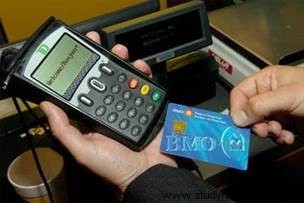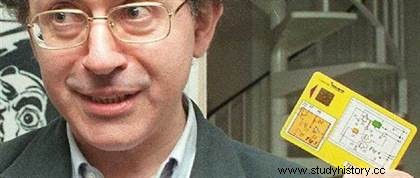 In 1974, Frenchman Roland Moreno invented the smart card , a plastic card with integrated circuits that will take off with the development of telephone cards and credit cards. The smart card then finds many other applications:the SIM card used in mobile phones, the Vitale card, the Moneo card, building access badges or subscription cards for prepaid services such as the telephone or transport tickets.
In 1974, Frenchman Roland Moreno invented the smart card , a plastic card with integrated circuits that will take off with the development of telephone cards and credit cards. The smart card then finds many other applications:the SIM card used in mobile phones, the Vitale card, the Moneo card, building access badges or subscription cards for prepaid services such as the telephone or transport tickets.
The smart card patent
Roland Moreno's invention - the smart card - is a plastic rectangle one millimeter thick that carries an integrated circuit capable of securely memorizing a series information. It brings together a microprocessor, a read only memory (or ROM), a storage memory and a random access memory of a variable size depending on the sum and the complexity of the information it will contain. This integrated circuit is mistakenly called a chip, because the latter is actually located below and is "hidden".
Before being put into circulation, the card is encoded in order to write the user's personal information into the chip. The first patent was filed on March 25, 1974 and described "a portable memory object claiming inhibiting means" (ensuring data protection) associated with "a comparator with an error comparator" (combination typically used for the use of the secret code associated with the card).
Roland Moreno, an atypical inventor
 The inventor is part of the "originals", closer to a "Géo Trouvetout" than a Steve Jobs . Born on June 11, 1945, in Cairo, Roland Moreno was passionate about electronics very early on. He passes his baccalaureate, drops out of college and then does a multitude of odd jobs:butcher, advertising designer, distributor of leaflets, office worker, sled builder, journalist-reporter at Detective, errand boy at L'Express, editorialist, columnist... In short, he is a self-taught jack-of-all-trades. He continues to invent throughout his life new machines more or less delirious. Among his finds, we can cite the dodder (which allows you to create new words algorithmically), the pianok (pocket piano) or the matapof (machine to shoot heads or tails).
The inventor is part of the "originals", closer to a "Géo Trouvetout" than a Steve Jobs . Born on June 11, 1945, in Cairo, Roland Moreno was passionate about electronics very early on. He passes his baccalaureate, drops out of college and then does a multitude of odd jobs:butcher, advertising designer, distributor of leaflets, office worker, sled builder, journalist-reporter at Detective, errand boy at L'Express, editorialist, columnist... In short, he is a self-taught jack-of-all-trades. He continues to invent throughout his life new machines more or less delirious. Among his finds, we can cite the dodder (which allows you to create new words algorithmically), the pianok (pocket piano) or the matapof (machine to shoot heads or tails).
In March 1972, he created the Innovatron association and then, in July, a company of the same name “to sell ideas”. Since 1975, it has been marketing brand or product names. He is also the author of a book, La Théorie du bordel ambient, in which he shares all of his thoughts on the world.
Forty-five patents
The industrial protection of its smart card will be extended by the filing of several certificates of addition and patents - such as the error counter, which causes the chip to self-destruct in the event of repeated submission of a false code- which rely on the basic patent, and by filings in eleven countries. Thanks to this technology, he made a fortune. It brings him 150 million euros, which is not without triggering controversy. Indeed, if he filed the patent, other inventors claim the paternity of the smart card. One of the most vehement was an engineer from the National Center for Telecommunications Studies (CNET) claiming to have had his idea stolen in 1973 by the Innovatron association. But despite numerous complaints, his steps were systematically rejected.
 In 2011, the Court of Cassation held that "there were no sufficient charges against anyone 'having committed the offenses charged, nor any other offence'. Others give credit for the invention to the Germans Jürgen Dethloff and Helmut Grôttrup, who would have developed it fifteen years earlier. But all these controversies in no way diminish the work of Moreno, who in 1996 received the Eduard Rhein prize, a prestigious German prize, in the technology category. He was even decorated with the Legion of Honor in 2009.
In 2011, the Court of Cassation held that "there were no sufficient charges against anyone 'having committed the offenses charged, nor any other offence'. Others give credit for the invention to the Germans Jürgen Dethloff and Helmut Grôttrup, who would have developed it fifteen years earlier. But all these controversies in no way diminish the work of Moreno, who in 1996 received the Eduard Rhein prize, a prestigious German prize, in the technology category. He was even decorated with the Legion of Honor in 2009.
The smart card:an expanding market
At the end of the 1990s, Roland Moreno's patents related to the smart card -like the electronic purse- fell into the public domain, but he remained head of his company Innovatron. When he died at the age of 66, on April 29, 2012, from a pulmonary embolism at his Parisian home, he was no longer receiving royalties on smart cards, but was still collecting fees on cards "without contacts» of the Velib' or Navigo type. Since then, the smart card market has continued to grow.
In 2011, 6.3 billion units were produced. Roland Moreno affirmed that his smart card had "a limited number of applications" -banking, telephone, car parks, television decoders and the health card-, and that beyond that, he said to himself "a little skeptical. Indeed, most of the production (75%) is intended for the telecommunications market (including SIM cards for mobile phones) and 16% for payment (bank cards). The number of smart card payments has exceeded that of check payments.
To go further
- Ambient Brothel Theory, by Roland Moreno. The Archipelago, January 2002.
- The 1001 inventions that changed the world, by Jack Challoner. Flammarion, 2010.
